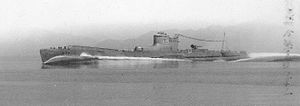Japanese submarine I-15
 I-15 during her initial sea trials
| |
| History | |
|---|---|
| Name | I-15 |
| Laid down | January 1938 |
| Launched | 7 March 1939 |
| Commissioned | 30 September 1940 |
| Stricken | 24 December 1942 |
| Fate | Sunk 10 November 1942 |
| General characteristics | |
| Class and type | Type B1 submarine |
| Displacement |
|
| Length | 108.7 m (357 ft) |
| Beam | 9.3 m (31 ft) |
| Draft | 5.14 m (16.9 ft) |
| Propulsion |
|
| Speed |
|
| Range | 14,000 nautical miles (26,000 km) at 16 knots (30 km/h) |
| Test depth | 100 m (330 ft) |
| Complement | 94 |
| Armament |
|
| Aircraft carried | 1 Yokosuka E14Y seaplane |
I-15 was a Japanese B1 type submarine. She was completed at Kure Navy Yard on September 30, 1940, whereupon she entered into service with the Imperial Japanese Navy. Her first and only commanding officer was Commander Nobuo Ishikawa. I-15 operated off the north coast of Oahu during the raid on Pearl Harbor. Her second wartime patrol, in May and June 1942, took her to the Aleutians, where she conducted reconnaissance of several islands. I-15's third and final patrol took place from August to November 1942, when she operated in the Solomon Islands in the South Pacific, supporting the Japanese efforts to hold Guadalcanal. One source (Morison) suggests that I-15 hit the battleship USS North Carolina with a torpedo on September 15, 1942. More recent authorities (Hackett & Kingsepp) maintain that the torpedo came from another submarine operating in the area, I-19, which was also responsible for the sinking of USS Wasp, which I-15 duly observed and reported. On November 10, 1942, a U.S. ex-destroyer (modified to a fast minesweeper), USS Southard, sank I-15 at Cape Recherche, San Cristóbal, with all hands lost.[2] Commander Ishikawa was promoted to the rank of Captain posthumously. On December 14, 1942, more than one month after I-15 was sunk, USS Wahoo sank an unknown submarine which it misidentified as the I-15.[3]
Notes
- ^ Campbell, John Naval Weapons of World War Two ISBN 0-87021-459-4 p.191
- ^ "Imperial submarines I-15". Combinedfleet.com. Retrieved 16 December 2012.
- ^ O'Kane 1987, pp. 96–98.
Sources
- Hackett, Bob & Kingsepp, Sander. HIJMS Submarine I-15: Tabular Record of Movement. http://www.combinedfleet.com/I-15.htm. Retrieved on March 15, 2009.
- Morison, Samuel Eliot. The Struggle for Guadalcanal, pp. 131–34, 233. Volume 5 of The History of United States Naval Operations in World War II (1949). Edison, NJ: Castle Books, 2001.
- O'Kane, Richard H. (1987), Wahoo: The Patrols of America's Most Famous WWII Submarine, Presidio Press, ISBN 978-0-89141-301-1.
